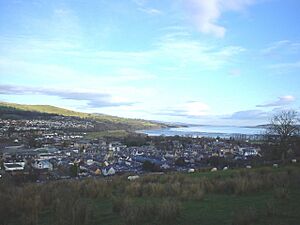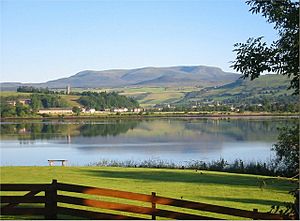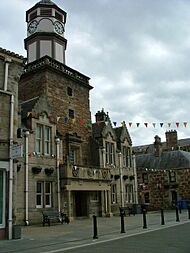Dingwall facts for kids
Quick facts for kids Dingwall
|
|
|---|---|
| Town and royal burgh | |
 Looking across Dingwall to the Cromarty Firth |
|
| Population | 5,360 (2020) |
| OS grid reference | NH550587 |
| • Edinburgh | 123 mi (198 km) |
| • London | 454 mi (731 km) |
| Council area | |
| Lieutenancy area | |
| Country | Scotland |
| Sovereign state | United Kingdom |
| Post town | DINGWALL |
| Postcode district | IV7, IV15, IV16 |
| Dialling code | 01349 |
| Police | Northern |
| Fire | Highlands and Islands |
| Ambulance | Scottish |
| EU Parliament | Scotland |
| UK Parliament |
|
| Scottish Parliament | |
| Website | http://www.dingwallcc.com |
Dingwall (Scots: Dingwal, Scottish Gaelic: Inbhir Pheofharain) is a town in the Highland council area of Scotland. It is known as a royal burgh, which is a special type of town. About 5,491 people live there.
Dingwall was once a busy harbour on the east coast. Today, it is located a bit further inland. The town has a rich history, including a famous castle.
Dingwall Castle used to be the largest castle north of Stirling. You can also find Tulloch Castle on the edge of town. Parts of Tulloch Castle might be as old as the 12th century. In 1411, a battle is said to have happened here. It was between the Clan Mackay and the Clan Donald.
Contents
History of Dingwall
Ancient Times
The name Dingwall comes from an old Scandinavian word, Þingvöllr. This means "field or meeting-place of the thing." A "thing" was a local assembly or meeting. This name shows the town's Viking connections. The Vikings invaded this area in the 8th century.
In Gaelic, the town is called Inbhir Pheofharain. This means "the mouth of the Peffery." Another Gaelic name is Baile Chàil, which means "cabbage town."
Middle Ages and Beyond
Dingwall Castle was built in the 11th century. It was known as the biggest castle north of Stirling. In 1226, King Alexander II made Dingwall a royal burgh. This meant it had special rights and was an important town. It also became the main town for the Earls of Ross.
An obelisk, which is a tall, thin stone pillar, stands near the church. It was built for George Mackenzie, 1st Earl of Cromartie, who died in 1717. The original obelisk started to lean. It was later replaced with a smaller one.
The Dingwall Town Hall was built in 1745. It is still standing today. Dingwall was once the main town for the area of Ross and Cromarty.
In 1845, many families in the Glencalvie area had to leave their homes. This was part of a sad time called the Highland Clearances. A poem in Gaelic was written about these events. It described what happened during these difficult times.
Modern Dingwall
Today, Dingwall has a special Heritage Trail. This trail was launched in 2023. It has information boards at important historical places around the town. This helps people learn about Dingwall's past.
The town has faced some challenges with flooding. In 2006 and again in 2019, heavy storms caused widespread flooding. This cut off the town and other parts of the Highlands.
In 2021, Dingwall's Post Office won an award. It was named the UK's most improved delivery office by Royal Mail.
Location and Travel

Dingwall is located near the top of the Cromarty Firth. It sits where the Peffery valley meets the land at the mouth of the Conon River. This is about 14 kilometres (9 miles) northwest of Inverness.
The town has a very short canal called the Dingwall Canal. People also call it the River Peffery. Dingwall railway station is on the Far North Line. This train line has been running since around 1865. It also connects to the Kyle of Lochalsh Line.
Dingwall used to be on the main road to the northern Highlands (the A9). However, since the Cromarty Bridge was built in 1979, the main road now goes around Dingwall. If you head west, the A834 road joins the A835 road. This is the main route to the northwest Highlands, including Ullapool.
Sports and Media
Dingwall is famous for its football team, Ross County. The team was promoted to the Scottish Premier League in 2012. They finished fifth in the 2012/13 season. Even though Dingwall is a small town, many fans come to Victoria Park to watch the team play.
Ross County reached the 2010 Scottish Cup Final. They even beat Celtic in an earlier round! In 2016, Ross County won their first major trophy. They won the Scottish League Cup by beating Hibernian 2–1 in the final.
For television, signals come from the Rosemarkie TV transmitter. There is also a local relay transmitter in Fodderty.
You can listen to several radio stations. These include BBC Radio Scotland (94.0 FM) and BBC Radio nan Gàidheal (104.9 FM) for Gaelic speakers. There is also MFR Radio (96.7 FM) and Highland FM (107.1 FM). Highland FM is a community radio station run by volunteers.
The local newspaper for the town is the Ross-shire Journal.
Education
Dingwall has a primary school called Dingwall Primary. This school serves the children living in the town.
Dingwall Academy is the secondary school. It serves students from Dingwall and the surrounding areas. These areas include places like Strathpeffer, Contin, Conon Bridge, Maryburgh, and Muir of Ord.
The Highland Theological College is also in Dingwall. It is part of the University of the Highlands and Islands. This college focuses on theological education. It helps train ministers and workers for different churches.
Parliamentary History
Dingwall was once a "parliamentary burgh." This meant it was a town that could send a representative to the House of Commons. From 1708 to 1918, Dingwall was grouped with other towns. These towns included Dornoch, Kirkwall, Tain, and Wick. Together, they formed a special voting area.
This group of towns was known as the Northern Burghs. Later, Cromarty was added to the list in 1832. This area was also called the Wick Burghs. It was represented by one Member of Parliament (MP).
In 1918, this special voting area was changed. Dingwall became part of the county constituency of Ross and Cromarty. This new area was then changed again in 1983.
Churches
Dingwall has several churches for different faiths:
- Dingwall and Strathpeffer Free Church of Scotland
- Dingwall Baptist Church
- Dingwall: Castle Street Church of Scotland
- Dingwall Evangelical Church
- Dingwall: Free Presbyterian Church of Scotland
- Dingwall: St Clement's Church of Scotland
- St James the Great Scottish Episcopal Church
- St Lawrence's Church, a Roman Catholic Church, opened in 1902.
Famous People from Dingwall
Many notable people have connections to Dingwall:
- James Fraser of Brea – a theologian who was once a prisoner.
- Prof James Alexander MacDonald (1908–1997) – a botanist who grew up in Dingwall.
- Major General Sir Hector Archibald MacDonald – the son of a local farmer.
- John M'Gilligen of Fodderty – known for holding religious meetings in homes.
- John Kennedy of Dingwall – a minister of the Free Church of Scotland.
- Rev Duncan Leitch – a Moderator of the General Assembly of the Free Church of Scotland in 1952.
- Julie Fowlis – a talented folk singer and musician.
- Kate Forbes – the Deputy First Minister of Scotland and a member of the Scottish Parliament. She was born and went to school in Dingwall.
- Thomas Simpson (explorer) – an Arctic explorer (1808–1840).
- Willie Logan – a civil engineer who started the aviation company Loganair.
- Colin Calder – the founder of Club Atletico Rosario Central in Argentina.
See also
 In Spanish: Dingwall (Escocia) para niños
In Spanish: Dingwall (Escocia) para niños



